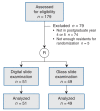Performance of residents using digital images versus glass slides on certification examination in anatomical pathology: a mixed methods pilot study
- PMID: 27280119
- PMCID: PMC4866926
- DOI: 10.9778/cmajo.20140075
Performance of residents using digital images versus glass slides on certification examination in anatomical pathology: a mixed methods pilot study
Abstract
Background: It is anticipated that many licensing examination centres for pathology will begin fully digitizing the certification examinations. The objective of our study was to test the feasibility of a fully digital examination and to assess the needs, concerns and expectations of pathology residents in moving from a glass slide-based examination to a fully digital examination.
Methods: We conducted a mixed methods study that compared, after randomization, the performance of senior residents (postgraduate years 4 and 5) in 7 accredited anatomical pathology training programs across Canada on a pathology examination using either glass slides or digital whole-slide scanned images of the slides. The pilot examination was followed by a post-test survey. In addition, pathology residents from all levels of training were invited to participate in an online survey.
Results: A total of 100 residents participated in the pilot examination; 49 were given glass slides instead of digital images. We found no significant difference in examination results between the 2 groups of residents (estimated marginal mean 8.23/12, 95% confidence interval [CI] 7.72-8.87, for glass slides; 7.84/12, 95% CI 7.28-8.41, for digital slides). In the post-test survey, most of the respondents expressed concerns with the digital examination, including slowly functioning software, blurring and poor detail of images, particularly nuclear features. All of the respondents of the general survey (n = 179) agreed that additional training was required if the examination were to become fully digital.
Interpretation: Although the performance of residents completing pathology examinations with glass slides was comparable to that of residents using digital images, our study showed that residents were not comfortable with the digital technology, especially given their current level of exposure to it. Additional training may be needed before implementing a fully digital examination, with consideration for a gradual transition.
Figures



Similar articles
-
Comparison of glass slides and various digital-slide modalities for cytopathology screening and interpretation.Cancer Cytopathol. 2017 Sep;125(9):701-709. doi: 10.1002/cncy.21880. Epub 2017 May 30. Cancer Cytopathol. 2017. PMID: 28558124
-
iPathology cockpit diagnostic station: validation according to College of American Pathologists Pathology and Laboratory Quality Center recommendation at the Hospital Trust and University of Verona.Diagn Pathol. 2014;9 Suppl 1(Suppl 1):S12. doi: 10.1186/1746-1596-9-S1-S12. Epub 2014 Dec 19. Diagn Pathol. 2014. PMID: 25565219 Free PMC article.
-
Randomized comparison of virtual microscopy and traditional glass microscopy in diagnostic accuracy among dermatology and pathology residents.Hum Pathol. 2009 May;40(5):662-7. doi: 10.1016/j.humpath.2008.10.009. Epub 2009 Jan 14. Hum Pathol. 2009. PMID: 19144382 Clinical Trial.
-
Whole slide imaging: uses and limitations for surgical pathology and teaching.Biotech Histochem. 2015 Jul;90(5):321-30. doi: 10.3109/10520295.2015.1033463. Epub 2015 Apr 22. Biotech Histochem. 2015. PMID: 25901738 Review.
-
Applications and challenges of digital pathology and whole slide imaging.Biotech Histochem. 2015 Jul;90(5):341-7. doi: 10.3109/10520295.2015.1044566. Epub 2015 May 15. Biotech Histochem. 2015. PMID: 25978139 Review.
References
-
- Gabril MY, Yousef GM. Informatics for practicing anatomical pathologists: marking a new era in pathology practice. Mod Pathol. 2010;23:349–58. - PubMed
-
- Jara-Lazaro AR, Thamboo TP, Teh M, et al. Digital pathology: exploring its applications in diagnostic surgical pathology practice. Pathology. 2010;42:512–8. - PubMed
-
- Weinstein RS. Innovations in medical imaging and virtual microscopy. Hum Pathol. 2005;36:317–9. - PubMed
-
- Cross SS, Dennis T, Start RD. Telepathology: current status and future prospects in diagnostic histopathology. Histopathology. 2002;41:91–109. - PubMed
-
- Evans AJ, Chetty R, Clarke BA, et al. Primary frozen section diagnosis by robotic microscopy and virtual slide telepathology: the University Health Network experience. Hum Pathol. 2009;40:1070–81. - PubMed
LinkOut - more resources
Full Text Sources
Other Literature Sources
